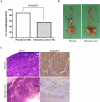Aldo-keto reductase family 1 member B10 prevents esophageal squamous cell carcinoma from reactive carbonyl species-induced cell death and promotes its progression
- PMID: 39710692
- PMCID: PMC11663324
- DOI: 10.1186/s12935-024-03623-8
Aldo-keto reductase family 1 member B10 prevents esophageal squamous cell carcinoma from reactive carbonyl species-induced cell death and promotes its progression
Abstract
Introduction: Chronic alcohol consumption and tobacco usage are major risk factors for esophageal squamous cell carcinoma (ESCC). Excessive tobacco and alcohol consumption lead to oxidative stress and the generation of reactive carbonyl species (RCS) which induce DNA damage and cell apoptosis. This phenomenon contributes to cell damage and carcinogenesis in various organs including ESCC. However, it also raises an important question on how ESCC cells evade RCS-induced apoptosis and grow rapidly under these conditions. Therefore, we hypothesize that some enzymes produced by ESCC cells are capable of catabolizing RCS, preventing ESCC neoplastic cells from undergoing RCS-induced apoptosis, potentially contributing to ESCC progression.
Methods: To identify significant gene clusters involved in the metabolism of RCS in ESCC, we used an Agilent SurePrint G3 Human V2 GE 8 × 60 K microarray kit to analyze differentially expressed genes between nine paired ESCC tissues and adjacent normal esophageal tissues taken from areas distant from the tumor site. Bioinformatics analysis using gene ontology (GO) was performed to categorize these genes. To validate the findings, immunohistochemical staining in specimens from 169 surgically resected ESCC patients was performed and then correlated with treatment outcomes. Furthermore, the identified signaling pathway and its biological effects were investigated in ESCC cell lines in vitro and 4-nitroquinoline 1-oxide (4-NQO)-induced-ESCC murine model in vivo.
Results: Interestingly, we found that one of the significantly altered 57 GO molecular function domain terms (GO:0004033 aldo-keto reductase activity; P = 0.021) between nine paired ESCC tumors and adjacent normal tissue specimens was associated with the RCS metabolism. Among significant genes within this domain, AKR1B10 (aldo-keto reductase family 1 member B10; P = 0.006) was identified as the most significantly altered gene. Immunohistochemical analysis revealed that AKR1B10 expression was higher in ESCC cells than in adjacent normal esophageal epithelium. In addition, AKR1B10 expression was independently significantly associated with a poorer prognosis in 169 ESCC patients. Enzyme-linked immunosorbent assay results further demonstrated that blood AKR1B10 concentrations were significantly higher in 72 ESCC patients than in 24 healthy controls. In vitro experiments revealed that inhibiting endogenous AKR1B10 enhanced the cytotoxicity of 4-hydroxy trans-2-nonenal, a type of RCS. In a 4-NQO-induced-ESCC murine model, oleanolic acid, an AKR1B10 inhibitor, significantly reduced the incidence of esophageal tumors.
Conclusions: Our findings suggested that AKR1B10 is an independent adverse prognosticator for patients with ESCC, and could prevent ESCC neoplastic cells from undergoing RCS-induced apoptosis, and promote ESCC progression. Therefore, AKR1B10 signaling could be a potential therapeutic strategy for ESCC.
Keywords: AKR1B10; ESCC; RCS.
© 2024. The Author(s).
Conflict of interest statement
Declarations. Ethics approval and consent to participate: This study was approved by the Chang Gung Medical Foundation Institutional Review Board (approval number: 201601568B0 and 202100927B0). All the methods were carried out in accordance with the approved guidelines, and written informed consent of the patients or their families was not judged necessary for this kind of retrospective study by the Chang Gung Medical Foundation Institutional Review Board. All animal experiments were approved by the Institutional Animal Care and Use Committee of the Chang Gung Memorial Hospital (2016112302). Consent for publication: Not applicable. Competing interests: The authors declare no competing interests.
Figures



References
-
- Bray F, Ferlay J, Soerjomataram I, Siegel RL, Torre LA, Jemal A. Global cancer statistics 2018: GLOBOCAN estimates of incidence and mortality worldwide for 36 cancers in 185 countries. CA Cancer J Clin. 2018;68(6):394–424. 10.3322/caac.21492. - PubMed
-
- Chung CS, Lee YC, Wang CP et al. Secondary prevention of esophageal squamous cell carcinoma in areas where smoking, alcohol, and betel quid chewing are prevalent. J Formos Med Assoc. 2010;109(6):408 – 21. (In eng). DOI: S0929-6646(10)60072-1 [pii] 10.1016/S0929-6646(10)60072-1 - PubMed
-
- Trachootham D, Alexandre J, Huang P. Targeting cancer cells by ROS-mediated mechanisms: a radical therapeutic approach? Nat Rev Drug Discovery. 2009;8(7):579–91. 10.1038/nrd2803. - PubMed
Grants and funding
LinkOut - more resources
Full Text Sources

